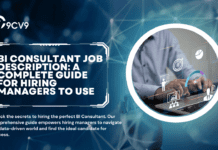Key Takeaways
- Change management software streamlines organizational transitions by automating workflows, improving collaboration, and reducing risks.
- Key features include impact assessment, approval tracking, reporting, and compliance monitoring to ensure smooth change implementation.
- Businesses benefit from enhanced efficiency, reduced downtime, and better adoption of changes, making the software essential for growth and adaptability.
In today’s fast-paced business environment, organizations must continuously evolve to remain competitive. Whether implementing new technologies, restructuring workflows, or adapting to market demands, change is an inevitable part of business growth.
However, managing change effectively is a complex process that requires strategic planning, coordination, and execution.
Without a structured approach, organizations risk inefficiencies, employee resistance, project failures, and financial losses.

This is where change management software plays a crucial role in ensuring smooth transitions and minimizing disruptions.
Change management software is designed to streamline, automate, and standardize the process of planning, executing, and monitoring organizational changes.
It provides a structured framework to facilitate seamless communication, mitigate risks, and track progress at every stage of change implementation.
From IT infrastructure updates and policy modifications to mergers and acquisitions, change management tools help businesses of all sizes manage transitions with minimal operational disruptions.
Why Change Management is Essential for Businesses
Change is often met with resistance, especially when employees and stakeholders are not adequately informed or prepared. Without a well-structured change management strategy, organizations face challenges such as:
- Lack of Clear Communication – Employees may struggle to understand why a change is happening and how it will impact their roles.
- Disruption to Productivity – Poorly managed transitions can lead to workflow interruptions, inefficiencies, and delays.
- Increased Risk of Errors – Manual tracking of change requests and approvals increases the likelihood of miscommunication and mistakes.
- Compliance and Security Risks – Failure to document and monitor changes properly can result in non-compliance with regulatory requirements.
- Loss of Employee Morale and Engagement – Resistance to change often stems from uncertainty and lack of involvement in decision-making.
By leveraging change management software, organizations can overcome these challenges and establish a transparent, structured, and systematic approach to managing change.
The Growing Need for Change Management Software in a Digital Era
As businesses embrace digital transformation, the complexity of managing change continues to grow. The shift to cloud computing, automation, artificial intelligence (AI), and remote work models requires businesses to implement changes more frequently and efficiently. Traditional manual methods, such as spreadsheets, emails, and paper-based approvals, are no longer sufficient to handle large-scale transitions. Organizations need data-driven, automated, and centralized change management solutions to remain agile and responsive to market demands.
Change management software offers an integrated platform to:
- Automate Change Request Processes – Streamline the submission, approval, and execution of changes.
- Enhance Collaboration Across Departments – Ensure all stakeholders are aligned and informed throughout the process.
- Mitigate Risks with Impact Analysis – Identify potential challenges and develop contingency plans before implementing changes.
- Ensure Compliance and Audit Readiness – Maintain detailed logs of all changes for regulatory and internal audits.
- Measure the Effectiveness of Changes – Use analytics and reporting tools to assess the impact of change initiatives.
What to Expect in This Guide
This blog will provide a comprehensive understanding of change management software, including its core functionalities, how it works, and the key benefits it offers to organizations. It will also explore the challenges businesses face when implementing such tools, review some of the top change management software available in 2024, and discuss the future trends shaping this industry. Whether you are an IT leader, project manager, or business executive, understanding how change management software works can help your organization optimize processes, reduce risks, and drive successful transformations.
By the end of this guide, you will have a clear roadmap for selecting and implementing the right change management software that aligns with your business goals, ensuring efficiency and long-term success. Let’s dive deeper into the world of change management software and discover how it revolutionizes business transformation.
What is Change Management Software and How It Works
- Understanding Change Management Software
- Core Features of Change Management Software
- How Change Management Software Works
- Benefits of Using Change Management Software
- Challenges & Considerations When Using Change Management Software
- How to Choose the Right Change Management Software
- Future Trends in Change Management Software
1. Understanding Change Management Software
Change management software is a specialized tool designed to facilitate, track, and manage organizational changes in a structured and efficient manner. It helps businesses implement changes with minimal disruption by providing automation, real-time monitoring, and communication features that keep all stakeholders informed and engaged throughout the change lifecycle.
- Enables organizations to plan, execute, and review change initiatives systematically.
- Reduces the risk of errors, inefficiencies, and operational disruptions during transitions.
- Enhances collaboration among teams by centralizing change requests, approvals, and documentation.
- Ensures compliance with industry regulations and internal governance policies.
- Integrates with IT service management (ITSM), enterprise resource planning (ERP), and other business process tools to streamline workflows.
How Change Management Software Differs from Traditional Change Management
Traditionally, change management was handled manually through spreadsheets, emails, and paper-based documentation. While this approach may work for small-scale changes, it becomes impractical for larger enterprises with complex processes and multiple stakeholders.
- Manual Approach
- Requires tracking changes through spreadsheets and emails.
- Lacks real-time visibility, making it difficult to monitor progress.
- Prone to human errors, miscommunication, and compliance risks.
- Automated Change Management Software
- Centralizes all change requests in a unified platform.
- Automates workflows for approvals, risk assessments, and progress tracking.
- Provides real-time updates, ensuring transparency and accountability.
Example:
A global IT company migrating its data centers to the cloud faces multiple risks, including service downtime, security vulnerabilities, and user disruptions. Using change management software like ServiceNow Change Management, the organization can automate approvals, assess potential risks, and execute changes in a phased approach to minimize business impact.
Key Industries That Benefit from Change Management Software
Change management software is widely used across multiple industries, particularly those undergoing frequent updates, compliance-driven changes, or digital transformation initiatives.
1. Information Technology (IT) and Software Development
- IT teams handle frequent software updates, security patches, and infrastructure upgrades.
- Change management software integrates with IT Service Management (ITSM) tools like BMC Helix ITSMand Jira Service Management to track changes and reduce system downtime.
- Ensures Change Advisory Boards (CABs) review and approve critical system changes before deployment.
2. Healthcare and Pharmaceuticals
- Helps manage compliance-driven changes such as regulatory updates and new medical protocols.
- Ensures smooth integration of Electronic Health Records (EHRs), minimizing risks to patient data security.
- Example: A hospital implementing a new telemedicine system uses change management software to ensure staff training, regulatory approvals, and patient data migration are executed properly.
3. Finance and Banking
- Banks and financial institutions frequently update policies to comply with government regulations.
- Automates approvals for financial policy changes and KYC (Know Your Customer) process modifications.
- Example: A bank updating its cybersecurity framework to meet ISO 27001 standards uses change management tools to coordinate IT security updates and compliance checks.
4. Manufacturing and Supply Chain
- Helps manufacturers implement new production processes, machinery upgrades, and Industry 4.0 automation.
- Ensures quality control measures are adhered to before rolling out production changes.
- Example: An automotive company transitioning to electric vehicle (EV) production uses change management software to align design modifications, supply chain adjustments, and compliance approvals.
5. Government and Public Sector
- Used to manage large-scale infrastructure projects, policy amendments, and digital governance initiatives.
- Ensures citizen services remain uninterrupted during administrative changes.
- Example: A city government rolling out smart city initiatives uses change management tools to track system upgrades in public transportation and waste management.
Core Functionalities of Change Management Software
Change management software comes with a range of functionalities to support organizations in managing change effectively.
1. Change Request Management
- Allows employees or IT teams to submit change requests through a centralized platform.
- Includes templates and predefined workflows to standardize requests.
- Example: An IT support team using SolarWinds Change Management can create and categorize change requests based on urgency and impact.
2. Risk and Impact Assessment
- Analyzes potential risks associated with proposed changes.
- Provides decision-makers with data-driven insights to approve or reject requests.
- Example: A software company rolling out a new AI-powered chatbot assesses risks such as system incompatibility and user adoption before deployment.
3. Automated Approval Workflows
- Ensures proper authorization from relevant stakeholders before executing changes.
- Reduces delays caused by manual approval processes.
- Example: A retail company integrating an AI-driven inventory management system automates approvals from supply chain, IT, and finance teams.
4. Change Execution and Implementation
- Defines steps to implement changes in a controlled manner.
- Enables phased rollouts to minimize operational disruptions.
- Example: A cloud computing firm migrating customer data to a hybrid cloud infrastructure executes changes incrementally to prevent service downtime.
5. Change Tracking and Audit Logs
- Maintains detailed records of all changes for compliance and accountability.
- Helps organizations pass audits and adhere to industry regulations.
- Example: A financial services company using ServiceNow ITSM can generate audit logs to comply with regulatory requirements.
6. Reporting and Analytics
- Provides real-time dashboards and reports on change performance metrics.
- Helps organizations refine change strategies based on historical data.
- Example: A tech startup tracking the impact of DevOps automation uses analytics from its change management tool to optimize future deployments.
Conclusion
Understanding change management software is crucial for businesses looking to streamline transitions and minimize risks. Unlike traditional manual methods, modern change management tools offer automation, real-time collaboration, and data-driven decision-making to ensure seamless execution of changes. From IT and finance to healthcare and manufacturing, businesses across industries rely on change management software to drive digital transformation, maintain compliance, and improve operational efficiency.
In the next section, we will explore how change management software works, breaking down the key steps organizations take to implement changes successfully.
2. Core Features of Change Management Software
Change management software is equipped with a range of features designed to streamline the planning, execution, and monitoring of organizational changes. These features help businesses maintain operational continuity, minimize risks, and ensure that changes align with business objectives. Below are the key features of change management software, along with relevant examples of how they enhance efficiency in different industries.
1. Centralized Change Request Management
A well-structured change request management system is crucial for tracking and processing change proposals efficiently.
- Provides a single platform for employees, IT teams, and stakeholders to submit change requests.
- Uses predefined templates to standardize requests and ensure consistency.
- Assigns priority levels to changes based on impact, urgency, and complexity.
- Example: In an IT service desk environment, ServiceNow Change Management enables IT teams to submit change requests categorized by low, medium, and high risk, ensuring efficient review and approval.
2. Automated Workflow and Approval Processes
Automation simplifies the change approval process, ensuring timely execution without delays.
- Routes change requests to appropriate stakeholders for review and approval.
- Implements rule-based approvals, reducing the need for manual intervention.
- Notifies relevant personnel via email or dashboard alerts when approval is needed.
- Example: A retail company using BMC Helix ITSM automates approvals for system upgrades, allowing executives and IT teams to greenlight updates without unnecessary bottlenecks.
3. Risk and Impact Assessment
Assessing risks before implementing changes is crucial to prevent operational disruptions.
- Conducts automated risk analysis based on historical data and predefined criteria.
- Evaluates the potential impact on business operations, customers, and compliance.
- Provides a risk scoring mechanism, flagging changes that require additional review.
- Example: A financial institution upgrading its cybersecurity protocols uses SolarWinds Change Management to conduct a risk assessment, identifying potential vulnerabilities before deployment.
4. Change Scheduling and Implementation Planning
Well-planned scheduling ensures that changes are implemented at the right time with minimal disruption.
- Offers calendar-based scheduling to plan changes during low-impact periods.
- Supports phased rollouts to minimize risks and test new implementations.
- Allows for rollback planning, ensuring quick restoration in case of failure.
- Example: A manufacturing company deploying new robotics automation schedules changes during off-peak production hours using Ivanti Change Management to prevent workflow disruptions.
5. Real-Time Collaboration and Communication
Effective communication is critical for ensuring alignment between teams and stakeholders.
- Provides a centralized dashboard where teams can track progress in real time.
- Integrates with collaboration tools like Slack, Microsoft Teams, and Jira to facilitate discussions.
- Offers automated notifications and alerts to keep all stakeholders informed.
- Example: A software development team using Jira Service Management enables developers, testers, and product managers to collaborate seamlessly on software updates.
6. Compliance and Audit Trail Management
Regulatory compliance and audit readiness are essential for businesses in highly regulated industries.
- Maintains detailed logs of all changes, approvals, and stakeholder interactions.
- Ensures compliance with industry regulations such as GDPR, HIPAA, and ISO 27001.
- Generates audit-ready reports, making it easier for organizations to pass compliance checks.
- Example: A healthcare provider managing patient data systems uses ServiceNow ITSM to document all changes and maintain HIPAA compliance.
7. Change Testing and Simulation
Testing changes before full implementation reduces the likelihood of errors and disruptions.
- Allows organizations to create sandbox environments to test changes before deployment.
- Simulates potential outcomes and analyzes risks using predictive analytics.
- Provides rollback capabilities in case the change leads to unexpected failures.
- Example: A cloud computing company updating its infrastructure uses AWS Change Manager to test software patches in a virtual environment before rolling them out to live systems.
8. Reporting and Performance Analytics
Analytics-driven insights help organizations assess the effectiveness of implemented changes.
- Generates customizable reports on change success rates, risks, and impact.
- Tracks key performance indicators (KPIs) such as change resolution time and failure rates.
- Uses AI-driven predictive analytics to optimize future change strategies.
- Example: A large IT enterprise using Freshservice Change Management analyzes reports to identify recurring issues and improve future change processes.
9. Integration with IT Service Management (ITSM) and Business Tools
Seamless integration with IT and business tools enhances workflow automation and efficiency.
- Connects with ITSM platforms such as ServiceNow, BMC Helix, and Atlassian Jira.
- Syncs with enterprise resource planning (ERP) systems like SAP and Oracle.
- Works alongside customer relationship management (CRM) tools for improved service delivery.
- Example: A telecommunications provider implementing a new customer service platform integrates its change management software with Salesforce CRM to align technical and customer support teams.
10. Change Knowledge Base and Documentation
Maintaining a knowledge base ensures that employees can access relevant information regarding changes.
- Stores documentation of past changes, helping teams learn from previous experiences.
- Provides step-by-step guides for implementing similar changes in the future.
- Enhances employee training and onboarding by offering a repository of change-related best practices.
- Example: A university upgrading its learning management system (LMS) documents all transition steps using ManageEngine Change Management to ensure smooth adoption by faculty and students.
11. Multi-Level Change Approval Hierarchy
For complex organizations, multi-level approval structures ensure that high-risk changes go through thorough review.
- Allows tiered approvals, ensuring executive-level sign-offs for critical changes.
- Implements custom approval workflows based on organizational hierarchy.
- Example: A government agency implementing new cybersecurity measures requires department heads, legal teams, and IT security officers to sign off on proposed changes before execution.
12. Automated Change Rollback and Recovery
When changes fail or cause disruptions, quick rollback mechanisms help restore normal operations.
- Provides automated rollback options to revert changes efficiently.
- Saves pre-change system snapshots to facilitate quick recovery.
- Example: A financial institution updating its online banking platform uses Ivanti Change Management to roll back to a previous version in case of unexpected system failures.
Conclusion
The core features of change management software play a crucial role in ensuring seamless transitions, minimizing risks, and maintaining compliance. From automated workflows and real-time collaboration to risk assessments and performance analytics, these tools empower organizations to manage change effectively.
With industries rapidly evolving due to technological advancements and regulatory changes, businesses must leverage robust change management solutions to stay competitive. In the next section, we will explore how change management software works in real-world applications and the step-by-step processes organizations use to implement changes successfully.
3. How Change Management Software Works
Change management software follows a structured, automated process to facilitate smooth transitions within an organization. It ensures that changes are properly planned, approved, implemented, and reviewed, minimizing risks and disruptions. Below is a step-by-step breakdown of how change management software works, along with relevant examples of real-world applications.
1. Identifying and Submitting a Change Request
Before any change is made, the process begins with identifying the need for change and submitting a request.
- Employees, IT teams, or managers can submit change requests through a centralized portal.
- Change requests must include key details such as the purpose, scope, risks, and expected impact.
- Organizations use predefined templates to ensure all necessary information is included.
- Example: A healthcare company upgrading its electronic medical records (EMR) system submits a request through ServiceNow Change Management, ensuring all stakeholders receive relevant details for review.
2. Categorizing and Prioritizing the Change
Once submitted, the request must be classified based on urgency, risk level, and impact.
- Changes are categorized into different types:
- Standard changes – Routine, low-risk changes (e.g., software updates).
- Normal changes – Require approval before implementation (e.g., system migrations).
- Emergency changes – Must be addressed immediately due to urgent risks (e.g., cybersecurity patches).
- Priority levels are assigned based on business impact, risk assessment, and resource availability.
- Example: A bank implementing a security upgrade uses BMC Helix ITSM to categorize the change as high-priority due to potential risks to customer data security.
3. Risk Assessment and Impact Analysis
Before approval, the proposed change undergoes a thorough risk and impact evaluation.
- The software automatically assesses risks based on historical data and predefined criteria.
- Affected departments, systems, and processes are identified to determine who and what will be impacted.
- High-risk changes undergo additional review by risk management teams before moving forward.
- Example: A manufacturing company upgrading its supply chain management software uses Ivanti Change Management to analyze risks related to production downtime and potential supplier disruptions.
4. Obtaining Approvals from Stakeholders
Change requests must go through an approval workflow before execution.
- Change management software automates the approval process, reducing manual efforts.
- Approvers include department heads, IT managers, compliance officers, and executives depending on the change type.
- The software sends real-time notifications to approvers, speeding up the process.
- Example: A telecommunications company rolling out a new customer billing system requires approval from the finance, IT, and legal teams before deployment using Freshservice Change Management.
5. Planning and Scheduling the Change
After approval, a detailed implementation plan is created, outlining the execution steps.
- Change managers define timelines, resource allocation, and task assignments.
- Changes are scheduled during low-impact periods to minimize disruptions.
- The software includes a calendar-based scheduling feature to align changes with business cycles.
- Example: A global retail company implementing a new inventory management system schedules the change for midnight hours using ManageEngine Change Management to avoid affecting daytime operations.
6. Testing the Change in a Controlled Environment
To prevent failures, changes are tested in a simulated environment before full deployment.
- Sandbox or staging environments are used to test functionality and detect potential issues.
- Test results help teams refine implementation plans and prepare for contingencies.
- Some software solutions offer AI-powered predictive analysis to simulate the expected impact.
- Example: A cloud service provider upgrading its server infrastructure uses AWS Change Manager to test performance and security aspects before making changes live.
7. Implementing the Change
Once testing is complete, the change is rolled out according to the implementation plan.
- Change implementation is automated wherever possible, reducing manual errors.
- Teams monitor real-time dashboards to track progress and resolve any issues.
- In case of failures, rollback mechanisms are available to restore previous settings.
- Example: An e-commerce platform deploying a new payment gateway uses Jira Service Management to track implementation progress and ensure smooth integration.
8. Monitoring and Incident Management During Implementation
Real-time monitoring ensures that changes are executed smoothly without disrupting operations.
- Software tools provide live tracking dashboards to observe system behavior.
- Incident management workflows are activated in case of failures or unexpected outcomes.
- Alerts and automated triggers notify IT teams about performance issues.
- Example: A global airline updating its flight scheduling system uses BMC Remedy ITSM to monitor live updates and ensure there are no booking errors.
9. Documenting the Change for Compliance and Future Reference
Change management software maintains detailed records of all changes for auditing and compliance purposes.
- Stores documentation, approvals, risk assessments, and test results in a centralized database.
- Ensures regulatory compliance with frameworks such as ISO 27001, GDPR, and HIPAA.
- Provides an audit trail for accountability and future reference.
- Example: A pharmaceutical company implementing new quality control software uses ServiceNow Change Management to maintain compliance documentation for FDA inspections.
10. Post-Implementation Review and Performance Analysis
After deployment, the change undergoes a review to assess its success and impact.
- Teams conduct a post-change evaluation to measure performance against expectations.
- Reports highlight key metrics such as system uptime, user adoption, and error rates.
- Lessons learned are documented to improve future change management processes.
- Example: A logistics company implementing an AI-driven route optimization tool analyzes delivery times and cost savings using SolarWinds Change Management after rollout.
11. Continuous Improvement and Optimization
Organizations continuously refine their change management processes using insights from past changes.
- Change management software provides AI-driven analytics to suggest improvements.
- Feedback from employees and customers is collected to fine-tune processes.
- Organizations update best practices and workflows to enhance efficiency.
- Example: A large IT enterprise deploying agile development frameworks uses Atlassian Jira Service Management to continuously adapt change workflows based on sprint retrospectives.
Conclusion
Change management software streamlines the entire process of identifying, approving, implementing, and monitoring organizational changes. By automating workflows, reducing risks, and ensuring compliance, these tools help businesses adapt to evolving industry demands.
From risk assessment and approval workflows to real-time monitoring and post-implementation analysis, change management software provides a structured approach that minimizes disruptions and maximizes efficiency. In the next section, we will explore the benefits of using change management software and how organizations can leverage these tools for long-term success.
4. Benefits of Using Change Management Software
Change management software offers numerous advantages for businesses by ensuring smooth transitions, reducing operational risks, and enhancing efficiency. Organizations that implement these tools can minimize disruptions, improve collaboration, and maintain regulatory compliance. Below is a detailed exploration of the key benefits of using change management software, along with relevant examples of real-world applications.
1. Improved Efficiency and Automation
Change management software streamlines processes by automating repetitive tasks and reducing manual intervention.
- Automated workflows eliminate the need for manual tracking and approvals.
- Reduces administrative workload by predefining change request templates and approval hierarchies.
- Enhances speed and accuracy by minimizing human errors in complex change processes.
- Example: A financial services company upgrading its core banking software automates approval workflows using ServiceNow Change Management, reducing processing time from weeks to days.
2. Enhanced Risk Management and Compliance
One of the primary benefits of change management software is its ability to mitigate risks and ensure compliance with industry regulations.
- Risk assessment tools analyze potential failures before implementation.
- Organizations can enforce compliance with regulations like ISO 27001, GDPR, HIPAA, and SOX.
- Audit trails keep records of every change for legal and compliance purposes.
- Example: A pharmaceutical company implementing a new drug-tracking system ensures compliance with FDA and GxP regulations using BMC Helix ITSM.
3. Greater Transparency and Accountability
Change management software provides full visibility into change processes, making it easier to track progress and hold individuals accountable.
- Centralized dashboards show real-time updates on pending, approved, and completed changes.
- Organizations can assign role-based permissions, ensuring that only authorized personnel can approve changes.
- Historical records help track decisions and responsibilities over time.
- Example: A government agency modernizing its cybersecurity infrastructure uses ManageEngine Change Management to monitor approvals and hold decision-makers accountable.
4. Reduced Downtime and Business Disruptions
With structured change management, organizations can implement changes with minimal impact on operations.
- Changes are scheduled during low-traffic periods to reduce disruptions.
- Rollback mechanisms ensure that systems can be restored quickly if issues arise.
- Prevents financial losses caused by unexpected service outages or failed implementations.
- Example: A global airline updating its flight booking system uses Jira Service Management to schedule changes during non-peak hours, minimizing disruptions for passengers.
5. Increased Collaboration Across Departments
Change management software fosters better communication and teamwork among different teams involved in the process.
- Cross-functional workflows ensure that IT, finance, HR, and other departments collaborate efficiently.
- Real-time notifications keep all stakeholders informed about changes in progress.
- Teams can provide feedback or raise concerns before final approval.
- Example: A large retail chain upgrading its inventory management system enables seamless collaboration between IT, supply chain, and store managers using Ivanti Change Management.
6. Faster Decision-Making and Change Implementation
By automating approvals and providing real-time insights, organizations can accelerate decision-making and implement changes more efficiently.
- Pre-configured approval workflows speed up the change request process.
- Decision-makers receive instant alerts and automated reminders for pending approvals.
- Organizations can implement changes quickly without delays caused by manual reviews.
- Example: A healthcare provider rolling out new patient record software reduces decision time from months to weeks using Freshservice Change Management.
7. Enhanced Change Tracking and Documentation
Proper documentation ensures that businesses can track historical changes, learn from past experiences, and maintain compliance.
- Comprehensive logs keep track of every change request, approval, and implementation step.
- Helps identify patterns and trends to improve future change processes.
- Ensures that organizations have a clear audit trail for regulatory and operational needs.
- Example: A cloud service provider managing frequent software updates tracks all deployments using AWS Change Manager, ensuring full documentation and compliance.
8. Better Employee and End-User Adoption
A well-managed change process increases the likelihood of successful adoption by employees and end-users.
- Change management software provides training and onboarding resources for employees.
- Ensures that users are properly informed before and after changes are implemented.
- Reduces resistance by offering step-by-step guidance and support tickets.
- Example: A university transitioning to a new learning management system ensures smoother adoption by integrating user guides and tutorials within BMC Remedy ITSM.
9. Improved IT Service Management (ITSM) and System Stability
IT teams benefit significantly from structured change management processes, ensuring that IT infrastructure remains stable and efficient.
- Prevents conflicts between simultaneous changes that might disrupt IT operations.
- Reduces the risk of unintended outages and security vulnerabilities.
- Ensures IT teams have better control over software updates, infrastructure changes, and security patches.
- Example: A telecommunications company implementing a 5G network upgrade ensures system stability using SolarWinds Change Management.
10. Cost Savings and ROI Optimization
Implementing change management software leads to financial benefits by reducing costly errors, downtime, and operational inefficiencies.
- Minimizes revenue losses caused by failed deployments or prolonged outages.
- Reduces manual labor costs by automating approvals, tracking, and reporting.
- Helps organizations avoid penalties for non-compliance with industry regulations.
- Example: A logistics company optimizing its fleet tracking system saves millions by ensuring flawless implementation with Atlassian Jira Service Management.
11. AI-Powered Insights and Predictive Analytics
Modern change management software integrates AI-driven analytics to enhance decision-making.
- AI predicts potential risks and failure points before changes are implemented.
- Machine learning models analyze past changes to recommend best practices.
- Improves overall IT governance and business process optimization.
- Example: A global SaaS provider deploying AI-driven customer service enhancements uses ServiceNow Change Management AI analytics to predict success rates.
12. Scalability for Growing Businesses
Change management software supports businesses of all sizes and scales as organizations grow.
- Cloud-based solutions allow businesses to manage multiple locations and teams.
- Supports multi-level approvals and large-scale deployments.
- Ensures consistency across multiple branches and international offices.
- Example: A multinational corporation launching a new ERP system across different regions scales efficiently using BMC Helix ITSM.
Conclusion
Change management software is a vital tool for businesses that need to implement changes smoothly, minimize risks, and optimize operational efficiency. From automating workflows and improving collaboration to ensuring compliance and enhancing IT stability, these solutions provide organizations with the structured approach needed to navigate transitions effectively.
With benefits such as reduced downtime, increased transparency, and cost savings, businesses can confidently manage transformations while maintaining productivity and service quality. As technology continues to evolve, AI-driven analytics and predictive insights will further enhance change management capabilities, ensuring organizations stay agile in an ever-changing business landscape.
5. Challenges & Considerations When Using Change Management Software
While change management software streamlines the process of implementing organizational changes, businesses often face challenges when adopting these solutions. Understanding these potential obstacles and key considerations is crucial to ensuring a smooth and effective transition. Below is an in-depth exploration of the challenges organizations encounter and factors to consider when using change management software, along with relevant examples.
1. Resistance to Change Among Employees
One of the most common challenges businesses face is resistance from employees who are accustomed to existing processes.
- Employees may fear job displacement due to automation.
- Lack of awareness about the benefits of change management software can lead to reluctance in adoption.
- Resistance is often stronger in organizations with a rigid, hierarchical culture.
- Solution: Conduct comprehensive training programs, workshops, and interactive Q&A sessions to familiarize employees with the software.
- Example: A hospital transitioning to electronic health records (EHR) faced initial pushback from doctors and nurses unfamiliar with digital documentation. A series of hands-on training sessions using ServiceNow Change Management helped staff adopt the system smoothly.
2. High Implementation Costs and Budget Constraints
Implementing change management software can require significant investment, which may not be feasible for all organizations.
- Licensing fees for premium software solutions can be expensive.
- Customization and integration with existing IT systems may require additional costs.
- Businesses may need to hire external consultants to facilitate implementation.
- Solution: Conduct a cost-benefit analysis to ensure ROI before selecting a change management tool. Consider open-source or cloud-based solutions to reduce upfront costs.
- Example: A mid-sized retail company hesitant to invest in an enterprise-level solution opted for Freshservice Change Management, a cloud-based tool that offered a lower-cost alternative with flexible pricing.
3. Complexity in Integration with Existing Systems
Integrating change management software with legacy IT systems, CRM, or ERP platforms can be technically challenging.
- Older systems may lack API support, making integration difficult.
- Data migration from legacy databases can lead to data loss or compatibility issues.
- Multiple departments using different software solutions can lead to synchronization challenges.
- Solution: Choose software with seamless integration capabilities and ensure IT teams perform rigorous testing before full-scale deployment.
- Example: A manufacturing company upgrading its supply chain management software encountered integration issues with its legacy ERP system. Using BMC Helix ITSM, they implemented a phased integration approach to ensure data consistency.
4. Inconsistent Change Processes Across Departments
Many organizations struggle with inconsistencies in how different departments handle changes, leading to misalignment.
- Departments may have conflicting priorities and approval hierarchies.
- Lack of standardized procedures can cause confusion and inefficiencies.
- Some teams may bypass official change processes, leading to unapproved modifications.
- Solution: Establish organization-wide standard operating procedures (SOPs) for managing change and ensure all departments follow uniform guidelines.
- Example: A global telecommunications company implementing 5G infrastructure faced challenges due to varying approval processes across regions. By using Jira Service Management, they standardized change workflows across all business units.
5. Security Risks and Data Privacy Concerns
Change management software involves handling sensitive business data, which can pose security risks if not managed properly.
- Unauthorized access to change requests can compromise system security.
- Cybersecurity threats like data breaches and insider threats can arise if security measures are weak.
- Compliance with data protection laws (e.g., GDPR, HIPAA, ISO 27001) is necessary to avoid legal repercussions.
- Solution: Implement role-based access control (RBAC), multi-factor authentication (MFA), and encrypted communication within change management platforms.
- Example: A financial institution deploying a new mobile banking application used Ivanti Change Management with built-in security features to comply with regulatory requirements.
6. Lengthy Approval Processes and Bureaucracy
Excessive bureaucracy in approving change requests can slow down innovation and operational efficiency.
- Multiple layers of approvals lead to delays in implementing critical changes.
- Decision-makers may hesitate to approve changes due to fear of disruptions.
- Over-reliance on manual approvals creates bottlenecks in the workflow.
- Solution: Use automated approval workflows and AI-powered recommendations to speed up decision-making. Define clear escalation protocols for urgent changes.
- Example: A healthcare provider updating its telemedicine software faced delays due to manual approvals. By implementing ServiceNow’s automated approval workflow, they reduced decision time by 50%.
7. Lack of User Training and Technical Expertise
Even the most advanced change management software will fail if users do not have the necessary knowledge and skills to operate it.
- Employees may struggle with complex interfaces and new features.
- Organizations with limited IT resources may find it difficult to manage software updates.
- A lack of proper training can lead to software underutilization.
- Solution: Invest in regular training sessions, user-friendly documentation, and customer support services to help employees maximize the software’s potential.
- Example: A university implementing an online learning platform provided staff and students with interactive tutorials and real-time support using BMC Remedy ITSM.
8. Poor Change Impact Assessment and Risk Analysis
Failure to properly assess risks before implementing changes can lead to unexpected failures or disruptions.
- Organizations may underestimate the impact of change on business continuity.
- Insufficient testing and rollback planning can increase the likelihood of failure.
- Risk assessment tools may not be fully utilized, leading to inaccurate predictions.
- Solution: Leverage AI-driven risk assessment tools to predict the impact of proposed changes before execution. Implement thorough testing in sandbox environments before deployment.
- Example: A logistics company updating its fleet management system used SolarWinds Change Management’s predictive risk analysis to minimize disruptions.
9. Scalability Issues for Growing Organizations
As businesses expand, their change management processes must scale accordingly. However, not all software solutions can handle rapid growth.
- Some platforms have limitations on the number of users or change requests.
- Large enterprises may require multi-region support and cloud scalability.
- Lack of scalable infrastructure can lead to performance issues in high-demand environments.
- Solution: Choose a cloud-based or enterprise-grade solution that can scale with business growth. Opt for tools that support multi-location deployment and global change management.
- Example: A tech startup expanding into multiple international markets adopted BMC Helix ITSM for its cloud scalability and multilingual support.
10. Measuring ROI and Effectiveness of Change Management Software
Businesses often struggle to quantify the effectiveness of their change management investments.
- Lack of clear KPIs makes it difficult to measure success.
- Stakeholders may question whether the software improves efficiency or just adds another layer of complexity.
- Difficulty in tracking ROI and cost savings after implementation.
- Solution: Define key performance indicators (KPIs) such as reduced downtime, faster change approvals, and fewer failed changes. Use analytics dashboards to monitor effectiveness.
- Example: A large insurance firm measuring ITSM improvements used Atlassian Jira’s analytics tools to track a 40% reduction in change-related service disruptions.
Conclusion
While change management software brings efficiency and structure to organizational transformations, businesses must proactively address common challenges to maximize its benefits. By considering factors such as employee adoption, integration complexity, security risks, and scalability, organizations can implement change more effectively while mitigating risks.
By investing in proper training, automating workflows, leveraging AI-driven risk assessment tools, and ensuring compliance, businesses can overcome obstacles and fully harness the potential of change management software for long-term success.
6. How to Choose the Right Change Management Software
Selecting the right change management software is crucial for organizations aiming to streamline transitions, minimize disruptions, and improve workflow efficiency. With numerous solutions available, businesses must assess their needs and evaluate software based on key features, integration capabilities, scalability, and security. This section provides a comprehensive guide on how to choose the best change management software, supported by relevant examples.
1. Identify Organizational Needs and Objectives
Before selecting change management software, organizations must define their goals and specific requirements.
- Assess existing challenges in handling change processes, such as approval bottlenecks, compliance issues, or employee resistance.
- Determine the scale of change management needs, whether for IT changes, organizational restructuring, or regulatory compliance.
- Define key performance indicators (KPIs) to measure software effectiveness, such as reduced downtime, faster change approvals, or increased compliance rates.
- Example: A financial institution needing strict regulatory compliance prioritized software with built-in auditing and reporting features, ultimately selecting BMC Helix ITSM for its robust compliance tools.
2. Evaluate Key Features and Functionalities
Change management software should include essential features to ensure seamless change implementation.
- Automated Change Request Workflows: Streamline approval processes and reduce manual intervention.
- Risk Assessment and Impact Analysis: Predict potential consequences of proposed changes before execution.
- Integration with IT Service Management (ITSM) Tools: Ensure compatibility with existing ticketing systems, such as Jira or ServiceNow.
- Audit Trails and Compliance Reporting: Maintain detailed logs for regulatory adherence.
- Role-Based Access Control (RBAC): Restrict access based on user roles to prevent unauthorized modifications.
- Example: A healthcare provider required compliance with HIPAA regulations and chose ServiceNow Change Management, which offers automated audit trails and security controls.
3. Consider Ease of Use and User Experience
A user-friendly interface is critical for successful adoption and efficient change management.
- Intuitive Dashboard and Navigation: Users should easily access key features without extensive training.
- Low Learning Curve: Minimize onboarding time with simplified workflows and interactive guides.
- Customization Options: Adapt software functionalities to match organizational change processes.
- Mobile Accessibility: Allow remote teams to approve and track changes via mobile applications.
- Example: A global consulting firm needed an easy-to-use change management platform and selected Freshservice, which provides an intuitive UI and a mobile-friendly interface.
4. Assess Integration Capabilities with Existing Systems
Seamless integration ensures that change management software works efficiently within an organization’s existing technology ecosystem.
- IT Service Management (ITSM) Integration: Connect with platforms like Jira Service Management, ServiceNow, or BMC Remedy.
- Collaboration Tools Compatibility: Work with Slack, Microsoft Teams, or Google Workspace for real-time communication.
- ERP and CRM System Integration: Sync with enterprise resource planning (ERP) and customer relationship management (CRM) platforms.
- API and Customization Support: Allow advanced integrations with third-party applications.
- Example: A large e-commerce company using SAP for ERP required a change management tool that integrates seamlessly, ultimately selecting Cherwell Change Management for its API-driven flexibility.
5. Ensure Scalability and Flexibility
Organizations should choose a change management solution that can grow with their business.
- Cloud-Based or On-Premises Deployment: Decide between cloud solutions for flexibility or on-premises for data control.
- Multi-Departmental Support: Ensure the software can handle enterprise-wide changes across various teams.
- Customizable Workflows: Adapt workflows to accommodate future process modifications.
- Multi-Region Support: Necessary for organizations with global operations.
- Example: A tech startup planning for rapid expansion selected BMC Helix ITSM due to its cloud-based scalability and global support capabilities.
6. Assess Security and Compliance Standards
Security is a critical factor when selecting change management software, especially for organizations handling sensitive data.
- Data Encryption: Protects data during transmission and storage.
- Role-Based Permissions: Restricts user access based on job responsibilities.
- Regulatory Compliance: Ensure the software meets GDPR, HIPAA, ISO 27001, or SOX compliance standards.
- Incident Tracking and Logging: Keep a detailed history of all changes for security audits.
- Example: A healthcare organization managing patient data opted for Ivanti Change Management, which offers robust HIPAA-compliant security measures.
7. Analyze Reporting and Analytics Features
Effective change management relies on data-driven decision-making.
- Real-Time Dashboards: Provide an overview of ongoing and completed change requests.
- Trend Analysis: Identify patterns in change success and failure rates.
- Customizable Reports: Generate detailed insights for compliance and performance reviews.
- AI-Powered Insights: Use artificial intelligence for predictive analytics and risk assessment.
- Example: A manufacturing company implementing large-scale process changes selected SolarWinds Change Management due to its AI-driven risk analysis capabilities.
8. Evaluate Pricing and Total Cost of Ownership (TCO)
Organizations should assess the full cost of software ownership, including licensing, implementation, and maintenance costs.
- Subscription-Based vs. One-Time Purchase: Determine whether a monthly subscription or a one-time license purchase is more cost-effective.
- Hidden Costs: Consider additional expenses for customizations, integrations, training, and support.
- ROI Analysis: Compare costs against expected productivity and efficiency gains.
- Free Trials and Demos: Test software before committing to a purchase.
- Example: A nonprofit organization with budget constraints chose Spiceworks Change Management, a free solution that met their basic requirements.
9. Review Customer Support and Vendor Reliability
Reliable customer support is essential for troubleshooting and ensuring smooth operation.
- 24/7 Support Availability: Essential for global organizations operating in multiple time zones.
- Dedicated Account Manager: Provides personalized assistance for enterprise clients.
- Community Forums and Knowledge Base: Allows self-service troubleshooting and peer discussions.
- Software Updates and Maintenance: Regular updates to enhance security and functionality.
- Example: A logistics company requiring fast issue resolution selected Atlassian Jira Service Management, which offers extensive online resources and responsive customer support.
10. Compare User Reviews and Industry Recommendations
Researching software reviews and industry analyst reports helps in making an informed decision.
- Gartner and Forrester Reports: Provide expert insights into top-performing software solutions.
- User Reviews on G2 and Capterra: Offer real-world experiences from other businesses.
- Case Studies and Testimonials: Showcase successful implementations in similar industries.
- Software Comparison Tools: Platforms like Capterra and TrustRadius allow side-by-side feature comparisons.
- Example: A mid-sized IT company chose ServiceNow Change Management after reviewing Gartner Magic Quadrant reports highlighting its industry leadership.
Conclusion
Selecting the right change management software requires a strategic approach, ensuring that the solution aligns with business goals, integrates with existing systems, and offers robust security and analytics. By carefully evaluating features, scalability, cost, and vendor reliability, organizations can streamline their change management processeswhile maximizing return on investment.
By considering user-friendly design, strong security measures, and reliable customer support, businesses can implement change with minimal resistance and drive long-term success.
7. Future Trends in Change Management Software
As businesses continue to evolve in response to digital transformation, regulatory changes, and shifting market demands, change management software is also advancing to meet modern challenges. Emerging trends indicate a greater reliance on artificial intelligence (AI), automation, data-driven decision-making, and cloud-based solutions. This section explores key future trends in change management software, providing insights into how organizations can prepare for upcoming innovations.
1. Artificial Intelligence (AI) and Machine Learning (ML) Integration
AI and ML are revolutionizing change management by enabling smarter decision-making, predictive analytics, and automation.
- Predictive Change Analysis: AI algorithms can analyze historical data to forecast the impact of proposed changes, helping organizations proactively address risks.
- Automated Risk Assessments: Machine learning models can assess the probability of change success or failure based on past trends.
- AI-Powered Chatbots: Virtual assistants can guide employees through change requests, approvals, and troubleshooting without human intervention.
- Example: ServiceNow Change Management integrates AI-powered virtual agents that assist in managing IT service changes efficiently.
2. Enhanced Automation for Streamlined Workflows
Automation is expected to play a larger role in reducing manual intervention and increasing efficiency in change processes.
- Self-Executing Workflows: Automated workflows ensure that change requests, approvals, and implementations follow predefined protocols with minimal human oversight.
- Automated Compliance Checks: Software will automatically verify whether proposed changes adhere to industry regulations.
- Auto-Generated Reports: Instant reports and dashboards will provide real-time insights into change progress.
- Example: BMC Helix ITSM uses automation to streamline IT change processes, reducing downtime and human error.
3. Cloud-Based and SaaS Change Management Solutions
Cloud technology is becoming the standard for change management software due to its scalability, accessibility, and cost-effectiveness.
- Remote Accessibility: Cloud-based solutions allow global teams to manage changes from anywhere.
- Subscription-Based Pricing Models: Software-as-a-Service (SaaS) models provide cost-effective alternatives to on-premises solutions.
- Seamless Software Updates: Vendors can deploy updates without requiring manual installations.
- Example: Freshservice Change Management offers a cloud-based approach, allowing IT teams to collaborate on change requests in real time.
4. Integration with Enterprise IT Ecosystems
Future change management software will offer seamless integration with other enterprise tools, enhancing overall efficiency.
- IT Service Management (ITSM) Integration: Change management will work in tandem with ITSM platforms like Jira Service Management and ServiceNow.
- DevOps Compatibility: Tools will integrate with CI/CD pipelines to align change management with software development lifecycles.
- Collaboration Tool Integration: Connection with platforms like Microsoft Teams, Slack, and Google Workspace will improve communication around changes.
- Example: Atlassian Jira Change Management integrates with DevOps tools for smoother deployment of software updates.
5. Data-Driven Change Management with Advanced Analytics
Organizations are leveraging data analytics to improve decision-making and optimize change strategies.
- Real-Time Dashboards: Provide instant insights into ongoing and completed change requests.
- Historical Trend Analysis: Helps organizations understand which changes were successful and which posed risks.
- AI-Driven Recommendations: AI suggests best practices based on previous change implementations.
- Example: SolarWinds Change Management uses data analytics to measure the effectiveness of IT changes.
6. Increased Focus on Security and Compliance
With rising cybersecurity threats and regulatory requirements, change management software is evolving to enhance security.
- Automated Security Checks: Software will automatically flag security risks in proposed changes.
- Blockchain for Change Tracking: Immutable blockchain records will improve transparency and accountability.
- Role-Based Access Control (RBAC): Restricts change approvals to authorized personnel only.
- Example: Ivanti Change Management ensures compliance with regulatory frameworks like GDPR, HIPAA, and ISO 27001.
7. User-Centric and Employee-Friendly Interfaces
Future software solutions will focus on improving user experience (UX) to drive higher adoption rates.
- No-Code/Low-Code Platforms: Enables non-technical employees to customize workflows.
- Mobile-Optimized Interfaces: Allows change requests and approvals via mobile applications.
- Interactive Tutorials and AI Assistance: Guides users through change management processes.
- Example: Cherwell Change Management offers a no-code environment, enabling organizations to configure workflows easily.
8. Hyper-Personalization of Change Management Processes
Organizations will increasingly tailor change management solutions to their unique requirements.
- AI-Driven Personalization: Software will recommend workflows based on an organization’s past behavior.
- Customizable Change Approval Hierarchies: Adaptable to different company structures and policies.
- Industry-Specific Solutions: Tailored software for sectors like healthcare, finance, and manufacturing.
- Example: BMC Helix Change Management allows businesses to configure industry-specific workflows.
9. Increased Adoption of Augmented Reality (AR) and Virtual Reality (VR)
AR and VR will transform change management training and simulation experiences.
- Immersive Change Simulations: Employees can experience proposed changes in a virtual environment before real-world implementation.
- Remote Collaboration via VR: Global teams can visualize and discuss changes in a shared virtual space.
- AR-Based Employee Training: Interactive guides help employees adapt to new systems.
- Example: Companies implementing large-scale infrastructure changes are exploring VR-based simulations to prepare employees for upcoming transformations.
10. Greater Emphasis on Change Management for Remote and Hybrid Workforces
With the rise of remote work, change management solutions will cater to distributed teams.
- Cloud-Based Change Collaboration: Ensures real-time tracking of remote change approvals.
- Automated Employee Onboarding for New Systems: AI-driven tutorials help remote employees adapt to new software.
- Digital Adoption Platforms (DAPs): Enhance user training by overlaying interactive guides on enterprise software.
- Example: WalkMe’s Digital Adoption Platform integrates with change management software to assist employees with process transitions.
Conclusion
The future of change management software is being shaped by AI-driven automation, cloud-based solutions, enhanced security, and seamless integrations with enterprise tools. Organizations that embrace these innovations will improve efficiency, minimize risks, and drive successful change adoption.
As businesses continue to navigate digital transformation, selecting future-ready change management software will be essential for long-term success.
Conclusion
Change is inevitable in any organization, and managing it effectively is crucial for maintaining operational stability, employee engagement, and long-term business success. Change management software has emerged as a vital tool for businesses seeking to streamline their change processes, minimize risks, and ensure smooth transitions. By automating workflows, enhancing collaboration, and providing data-driven insights, these solutions empower organizations to implement changes with greater efficiency and control.
Key Takeaways on Change Management Software
- Definition and Purpose: Change management software helps organizations plan, track, and implement changes across various departments while mitigating risks and improving compliance.
- Core Features: The software typically includes workflow automation, impact assessment, reporting and analytics, approval processes, and compliance tracking, ensuring structured and transparent change execution.
- How It Works: By integrating with existing IT and business tools, change management software facilitates communication, automates approval workflows, and provides real-time monitoring, allowing for seamless transitions.
- Benefits: Organizations benefit from improved efficiency, reduced downtime, enhanced regulatory compliance, better risk management, and stronger employee adoption of changes.
- Challenges & Considerations: While change management software offers numerous advantages, businesses must address adoption challenges, integration complexities, data security concerns, and cost implications to maximize its effectiveness.
- Choosing the Right Solution: Businesses should evaluate software options based on scalability, integration capabilities, user-friendliness, customization options, security features, and industry-specific needs to ensure a tailored fit.
- Future Trends: AI-driven automation, predictive analytics, cloud-based solutions, enhanced security measures, and greater integration with ITSM and DevOps tools are shaping the future of change management software.
The Growing Importance of Change Management Software in Modern Business
In today’s fast-paced digital landscape, organizations cannot afford to rely on outdated, manual change management processes. As industries undergo rapid transformations due to technological advancements, regulatory shifts, and evolving market demands, the ability to efficiently manage change has become a competitive advantage. Businesses that embrace intelligent, automated change management solutions can navigate disruptions more effectively and ensure continuous improvement in their operations.
Furthermore, the increasing adoption of remote and hybrid work environments has emphasized the need for cloud-based change management tools that enable global teams to collaborate seamlessly. Companies that fail to implement structured change processes may experience disruptions, employee resistance, and compliance issues, ultimately affecting their growth and reputation.
Why Businesses Should Invest in Change Management Software
For businesses aiming to achieve long-term resilience and scalability, investing in robust change management software is no longer an option—it is a necessity. Organizations that implement these solutions can:
- Accelerate decision-making by leveraging AI-powered analytics and predictive insights.
- Enhance team collaboration by integrating with enterprise communication and workflow tools.
- Ensure regulatory compliance by automating approval workflows and documentation tracking.
- Minimize risks and disruptions by proactively identifying potential roadblocks.
- Drive employee adoption by providing structured training and support throughout transitions.
Final Thoughts
Change management software is a strategic investment that enables organizations to adapt, grow, and stay competitive in a dynamic business environment. By selecting the right solution and leveraging emerging technologies, businesses can transform their change management processes into a well-structured, data-driven, and agile approach that fosters long-term success.
As organizations continue to evolve, the demand for scalable, intelligent, and automation-driven change management solutions will only increase. By staying ahead of industry trends and implementing best-in-class change management software, businesses can ensure seamless transitions, improved productivity, and a culture of continuous innovation.
If you find this article useful, why not share it with your hiring manager and C-level suite friends and also leave a nice comment below?
We, at the 9cv9 Research Team, strive to bring the latest and most meaningful data, guides, and statistics to your doorstep.
To get access to top-quality guides, click over to 9cv9 Blog.
People Also Ask
What is change management software?
Change management software is a digital tool that helps organizations plan, track, and implement changes efficiently while minimizing risks and disruptions.
How does change management software work?
It automates workflows, manages approvals, tracks progress, and ensures compliance by providing a structured approach to handling organizational changes.
Why is change management software important?
It streamlines change processes, reduces errors, improves collaboration, and ensures a smooth transition while maintaining business continuity.
What are the key features of change management software?
Core features include workflow automation, impact analysis, approval tracking, reporting, compliance management, and real-time monitoring.
Who can benefit from using change management software?
Businesses of all sizes, IT teams, HR departments, project managers, and organizations undergoing digital transformation can benefit from it.
What industries use change management software?
Industries like IT, healthcare, finance, manufacturing, and retail use it to manage operational changes effectively and ensure compliance.
How does change management software improve efficiency?
It reduces manual processes, automates approvals, and ensures seamless coordination, minimizing delays and improving workflow efficiency.
Can change management software help with compliance?
Yes, it ensures that changes follow regulatory requirements by maintaining audit trails, documentation, and approval workflows.
Is change management software only for IT teams?
No, it is used across departments, including HR, operations, and finance, to manage changes in policies, processes, and technology.
How does change management software reduce risks?
By providing impact assessments, automated approvals, and real-time tracking, it helps organizations anticipate and mitigate potential risks.
What is an example of change management software?
Popular examples include ServiceNow Change Management, BMC Helix ITSM, Freshservice, and Jira Service Management.
How does change management software integrate with other tools?
It integrates with ITSM, project management, collaboration, and enterprise resource planning (ERP) systems for seamless change execution.
Can small businesses use change management software?
Yes, many solutions offer scalable options tailored for small businesses to manage change efficiently without complex implementations.
What is the difference between change management and project management software?
Change management software focuses on implementing organizational changes, while project management software manages tasks, deadlines, and team collaboration.
Does change management software support remote teams?
Yes, cloud-based solutions allow remote teams to collaborate, track changes, and manage approvals from anywhere.
How does AI impact change management software?
AI enhances predictive analytics, automates approvals, and provides insights to optimize change processes and minimize risks.
What is the role of automation in change management software?
Automation streamlines approvals, tracks change progress, and reduces manual intervention, improving efficiency and accuracy.
How does change management software enhance decision-making?
It provides real-time data, impact assessments, and risk analysis to support informed decision-making during change implementation.
What are common challenges in using change management software?
Challenges include user adoption, integration complexities, cost, and ensuring the software aligns with business needs.
How do you choose the right change management software?
Consider factors like scalability, ease of use, integration capabilities, security features, and industry-specific needs before selecting a solution.
Can change management software be customized?
Yes, many platforms offer customization options to tailor workflows, notifications, and reporting based on organizational requirements.
Is training required to use change management software?
Basic training is usually required to ensure teams understand the software’s features, workflows, and reporting capabilities.
How does change management software handle approvals?
It automates multi-level approval processes, ensuring that proposed changes go through necessary authorizations before implementation.
Can change management software track historical changes?
Yes, it maintains logs and audit trails of past changes, providing a reference for compliance and future decision-making.
What are the cost considerations for change management software?
Costs vary based on features, user licenses, deployment type (cloud or on-premise), and support options.
How does cloud-based change management software differ from on-premise solutions?
Cloud-based solutions offer flexibility, remote access, and lower upfront costs, while on-premise solutions provide greater control over data security.
Can change management software improve employee adoption of new processes?
Yes, by providing structured implementation plans, training, and real-time tracking, it helps employees adapt to changes more effectively.
How does change management software support digital transformation?
It enables organizations to implement new technologies, workflows, and strategies while minimizing disruptions and ensuring smooth transitions.
What are future trends in change management software?
Trends include AI-powered automation, predictive analytics, enhanced integrations, cloud-based solutions, and improved user experiences.































![Writing A Good CV [6 Tips To Improve Your CV] 6 Tips To Improve Your CV](https://blog.9cv9.com/wp-content/uploads/2020/06/2020-06-02-2-100x70.png)


